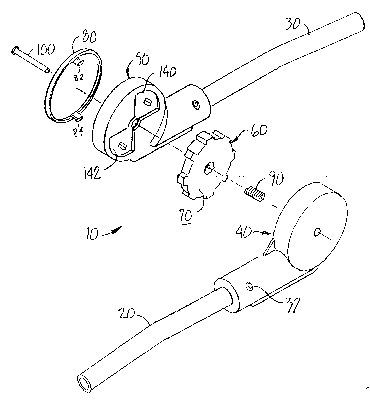Some of the information on this Web page has been provided by external sources. The Government of Canada is not responsible for the accuracy, reliability or currency of the information supplied by external sources. Users wishing to rely upon this information should consult directly with the source of the information. Content provided by external sources is not subject to official languages, privacy and accessibility requirements.
Any discrepancies in the text and image of the Claims and Abstract are due to differing posting times. Text of the Claims and Abstract are posted:
| (12) Patent Application: | (11) CA 2171166 |
|---|---|
| (54) English Title: | ROTATABLE BENDING JOINT FOR COLLAPSIBLE PLAYPEN |
| (54) French Title: | JOINT PLIANT TOURNANT AUTOUR D'UN AXE POUR PARCS POUR ENFANTS PLIANTS |
| Status: | Deemed Abandoned and Beyond the Period of Reinstatement - Pending Response to Notice of Disregarded Communication |
| (51) International Patent Classification (IPC): |
|
|---|---|
| (72) Inventors : |
|
| (73) Owners : |
|
| (71) Applicants : | |
| (74) Agent: | SMART & BIGGAR LP |
| (74) Associate agent: | |
| (45) Issued: | |
| (22) Filed Date: | 1996-03-06 |
| (41) Open to Public Inspection: | 1996-11-02 |
| Examination requested: | 1998-04-28 |
| Availability of licence: | N/A |
| Dedicated to the Public: | N/A |
| (25) Language of filing: | English |
| Patent Cooperation Treaty (PCT): | No |
|---|
| (30) Application Priority Data: | ||||||
|---|---|---|---|---|---|---|
|
An improved rotatable joint of the kind
disclosed in U.S. Pat. No. 5,381,570 for foldable
tubular playpen frames having a step in the tooth of
a recessed sprocket portion in which a connecting
gear rests. In order to unlock the joint one must
move the gear axially inwardly with a pushbutton as
well as relieve the stresses on the joint by lifting
up the tubular bars connected to the joint so that
the gear may slip off the step. In this way an
additional factor of safety is built-in in order to
unlock the joint, and accidental release is reduced.
Note: Claims are shown in the official language in which they were submitted.
Note: Descriptions are shown in the official language in which they were submitted.

2024-08-01:As part of the Next Generation Patents (NGP) transition, the Canadian Patents Database (CPD) now contains a more detailed Event History, which replicates the Event Log of our new back-office solution.
Please note that "Inactive:" events refers to events no longer in use in our new back-office solution.
For a clearer understanding of the status of the application/patent presented on this page, the site Disclaimer , as well as the definitions for Patent , Event History , Maintenance Fee and Payment History should be consulted.
| Description | Date |
|---|---|
| Time Limit for Reversal Expired | 2003-03-06 |
| Application Not Reinstated by Deadline | 2003-03-06 |
| Deemed Abandoned - Conditions for Grant Determined Not Compliant | 2002-03-19 |
| Deemed Abandoned - Failure to Respond to Maintenance Fee Notice | 2002-03-06 |
| Notice of Allowance is Issued | 2001-09-19 |
| Letter Sent | 2001-09-19 |
| Notice of Allowance is Issued | 2001-09-19 |
| Inactive: Approved for allowance (AFA) | 2001-08-30 |
| Amendment Received - Voluntary Amendment | 2001-02-22 |
| Inactive: S.30(2) Rules - Examiner requisition | 2001-01-15 |
| Inactive: RFE acknowledged - Prior art enquiry | 1998-07-22 |
| Inactive: Application prosecuted on TS as of Log entry date | 1998-07-21 |
| Inactive: Status info is complete as of Log entry date | 1998-07-21 |
| All Requirements for Examination Determined Compliant | 1998-04-28 |
| Request for Examination Requirements Determined Compliant | 1998-04-28 |
| Application Published (Open to Public Inspection) | 1996-11-02 |
| Abandonment Date | Reason | Reinstatement Date |
|---|---|---|
| 2002-03-19 | ||
| 2002-03-06 |
The last payment was received on 2001-02-15
Note : If the full payment has not been received on or before the date indicated, a further fee may be required which may be one of the following
Please refer to the CIPO Patent Fees web page to see all current fee amounts.
| Fee Type | Anniversary Year | Due Date | Paid Date |
|---|---|---|---|
| MF (application, 2nd anniv.) - standard | 02 | 1998-03-06 | 1998-03-06 |
| Request for examination - standard | 1998-04-28 | ||
| MF (application, 3rd anniv.) - standard | 03 | 1999-03-08 | 1999-03-02 |
| MF (application, 4th anniv.) - standard | 04 | 2000-03-06 | 2000-02-18 |
| MF (application, 5th anniv.) - standard | 05 | 2001-03-06 | 2001-02-15 |
| Registration of a document | 2001-06-07 |
Note: Records showing the ownership history in alphabetical order.
| Current Owners on Record |
|---|
| GRACO CHILDREN'S PRODUCTS INC. |
| Past Owners on Record |
|---|
| DANIEL P. SUMSER |
| MARK A. SEDLACK |
| SANDRA KAY STRANSKI |